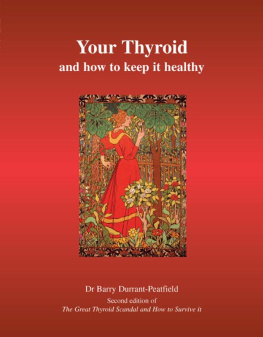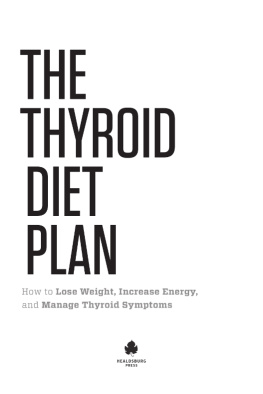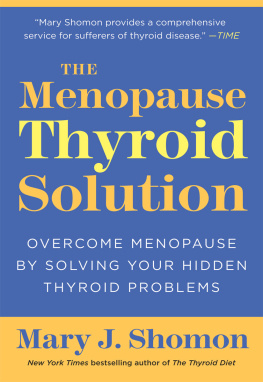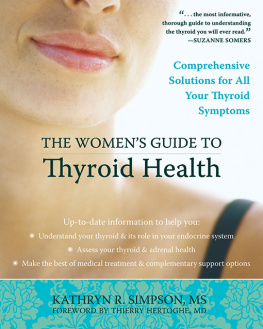
CHAPTER ONE
The Hidden Illness
Thyroid disease is common and affects women more frequently than men.
Many books and articles on thyroid problems for both the general public and medical profession begin with these or similar words. But this bland statement barely begins to suggest the number of women afflicted by thyroid problems or the impact of thyroid disorders on our lives. In fact, according to a review in the British Medical Journal, taken together, underactive and overactive thyroid conditions represent the most common hormonal problem and this problem overwhelmingly affects women.
In terms of statistics alone, thyroid problems in women deserve to be taken seriously:
Four out of five people with thyroid disorders are women.
One in 10 women will develop a thyroid disorder at some stage in her life.
Between one and two in 100 women in the UK will develop an underactive thyroid (hypothyroidism), a condition 10 times more common in women than men.
Two out of every 25 women and one in 10 past the menopause have so-called mild thyroid failure that is considered borderline on blood tests. These subclinical problems are linked with nagging ill health, such as fatigue, mood swings and overweight, as well as more serious medical problems such as depression, heart disease and osteoporosis.
Overactive thyroid conditions (hyperthyroidism) are also common in women, affecting between five in every 1000 to one in 50 or 10 times more women than men.
One in every 100 people in the UK will develop an autoimmune thyroid disorder, when the body turns against itself to cause the thyroid to become either underactive or overactive. Autoimmune disorders, including those affecting the thyroid, are estimated to be the third biggest killer after heart disease and cancer.
Having a personal or family history of autoimmune disorders, such as diabetes or rheumatoid arthritis, gives you a 25 per cent greater risk of developing a thyroid disease than someone without such a history.
Hashimotos thyroiditis an autoimmune disorder causing an underactive thyroid may account for up to one-third of such cases in this country and is five times more common in women than men.
Graves disease an autoimmune condition causing an overactive thyroid is 15 times more likely to affect you if you are a woman.
Goitre (a swollen or enlarged thyroid gland) is four times more common in women than in men.
Thyroid nodules or lumps are also more common in women estimated to affect about one in 20 women.
Thyroid cancer, although rare, is also more likely to develop if you are a woman.
Only as Healthy as Your Thyroid?
Thyroid problems can affect a woman at any age or stage in life from the teens to retirement. Throughout this time, they are a source of much ill health and unhappiness. During the reproductive years and after the menopause, they can exacerbate other female health problems as well as create a host of debilitating symptoms that affect every system of the body:
Thyroid problems can cause menstrual disturbances, such as heavy or absent periods, and worsen problems such as premenstrual syndrome (PMS).
Thyroid problems are an underrecognized cause of fertility problems and miscarriage.
During pregnancy, thyroid disorders are the most common hormonal problem.
Even a mild shortage of thyroid hormone during pregnancy may affect the unborn childs future IQ (intelligence quotient). Research shows that children, aged seven to nine, whose mothers had untreated hypothyroidism during pregnancy scored about seven points lower on IQ tests.
According to US research, women with faulty thyroid function are more likely to give birth to babies with defects of the heart, brain or kidney, or have abnormalities such as a cleft lip or palate, or extra fingers.
Babies whose mothers have an underactive thyroid have an increased risk of heart problems even if their mothers are being treated for the condition. Yet, at the time of writing, the NHS still does not routinely test thyroid function in pregnancy.
One in 10 young women have thyroid problems after giving birth, with symptoms such as depression, tiredness and a lack of zest that cast a shadow over the first months of parenthood. Such symptoms are often misdiagnosed as the baby blues, thus depriving women of treatment that would help.
Later in life, thyroid disease becomes even more common. An estimated one in 10 women over 40 may have undiagnosed thyroid disease, which is particularly worrying as thyroid problems are associated with an increased risk of two very significant causes of female ill health in later life: heart disease and osteoporosis (brittle-bone disease).
One in five women over 60 suffer thyroid problems. With the baby-boomers reaching this age, thyroid disorders will become an increasingly major health challenge.
Thyroid disease in older women is more likely to be silent, producing few or vague symptoms. But compared with, say, high blood pressure another silent disease with serious consequences thyroid problems are far less likely to be suspected or tested for.
These facts and figures alone put thyroid disease on a par with conditions like diabetes, estimated to affect one to two in every 100 people, and breast cancer, which strikes one in eight women. However, thyroid problems attract only a fraction of the research funding given to these high-profile conditions, and have until only recently relatively poor media coverage. That this is now beginning to change was reflected by an editorial in the prestigious British medical journal The Lancet that declared youre only as healthy as your thyroid.
Are Times Changing?
During the writing of the first edition of this book more than seven years ago, there was little awareness even among journalists specializing in womens health of just how common thyroid problems are and of the misery they can cause. A small request for help placed in The Guardian newspaper resulted in a deluge of phone calls: 200 over two days.
Revisiting thyroid problems now, has anything changed? The good news is that there has been a shift in knowledge and attitudes. A great deal more is becoming understood in terms of how thyroid problems are caused and how they may best be treated. And certainly, many more people are now aware of thyroid disease than in 1995.
Part of this new awareness is thanks to a number of books drawing attention to the wide-ranging effects of thyroid problems and the misery they can cause. The advent of the Internet has also done much to fill the information gap. There are now several excellent websites where women with thyroid problems can get information and communicate with others who have the same condition. This is good news for the millions of women living with a faulty thyroid.
However, in other aspects, the changes have been pitifully few. Thyroid disease is still a Cinderella disorder, despite being the cause of so much depression, tiredness, discomfort and feeling well below par. Even nowadays, women often soldier on for long periods before anyone takes their complaints seriously hardly surprising given that the average medical student only has a lecture or two on thyroid problems, if theyre lucky. And although there are more post-training courses for interested doctors, endocrinology (the study of hormones) is still not a core subject in most basic medical courses.
Like their sisters in 1995, many of the women interviewed for this new edition had struggled on for months, even years, with crippling symptoms before being diagnosed. Once diagnosed, they had to cope with unsympathetic doctors and endure treatments that were uncertain, took time to get right and sometimes didnt work at all.
Next page








